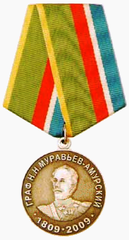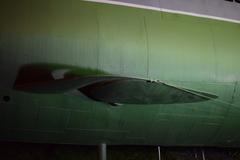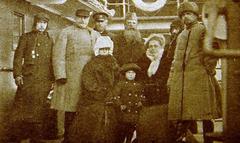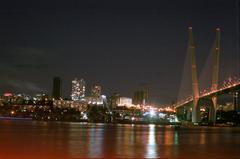
Vtoraya Rechka Visiting Hours, Tickets, and Historical Sites in Vladivostok
Date: 04/07/2025
Introduction to Vtoraya Rechka and Its Historical Significance
Vtoraya Rechka—translating to “Second River”—is a distinctive district within Vladivostok, Russia’s principal Far Eastern port. Renowned for its historical depth, cultural diversity, and scenic river landscapes, Vtoraya Rechka traces its roots back to 1860, when it was established as a fortified military outpost. Throughout the Soviet era, its strategic location contributed to the city’s closed status, leaving a legacy of Soviet architecture and military monuments.
Today, Vtoraya Rechka serves as a vibrant hub, easily accessible via the Vtoraya Rechka railway station on the Trans-Siberian Railway. The district is home to notable landmarks such as the Monument to Admiral Stepan Makarov and several parks along the Second River, which offer tranquil settings for recreation. Local markets reflect the multicultural character of Vladivostok, with Russian, Korean, Chinese, and Vietnamese influences. Comprehensive visitor information on hours, ticketing, and accessibility ensures a smooth experience, while excellent transit links connect Vtoraya Rechka to Vladivostok’s city center and nearby attractions like Russky Island and the Botanical Garden.
For history enthusiasts, nature lovers, and travelers seeking authentic cultural encounters, Vtoraya Rechka provides a well-rounded and engaging destination. This guide consolidates essential information, historical context, and practical tips to prepare you for a rewarding exploration of one of Vladivostok’s most emblematic districts (military-review.com, explorecity.life, rbth.com).
Table of Contents
- Introduction & Historical Significance
- Early Development and Strategic Foundations
- The Soviet Era: Transformation and Expansion
- Historical Significance and Legacy
- Cultural and Social Fabric
- Practical Visitor Information
- Exploring Vtoraya Rechka: Highlights for Visitors
- Visiting Vtoraya Rechka: A Guide to Its Urban River and Cultural Landmarks
- Visiting the Monument to Admiral Stepan Makarov
- Visitor Information, Transportation, and Attractions Guide
- Practical Visitor Tips
- Frequently Asked Questions (FAQ)
- Conclusion & Call to Action
- References
Early Development and Strategic Foundations
Vtoraya Rechka’s origins are closely linked to Vladivostok’s founding as a military stronghold on Russia’s Pacific frontier in 1860 (military-review.com). Its natural geography, with rivers and bays shielding the Muravyov-Amursky Peninsula, provided ideal conditions for defense and settlement. The district supported the city’s military infrastructure and contributed to Vladivostok’s growth as a major port and garrison.
The Soviet Era: Transformation and Expansion
Closed City Status and Military Importance
During the Soviet era, Vladivostok was a closed city, especially from 1958 through the late 1980s, due to its role as headquarters of the Soviet Pacific Fleet (explorecity.life). Vtoraya Rechka hosted military housing, supply depots, and facilities for personnel, shaping the district’s development and urban fabric.
Soviet Urban Planning and Architecture
Vtoraya Rechka’s landscape is characterized by mid-century Soviet apartment blocks (khrushchyovkas and brezhnevkas), wide avenues, and communal parks. The Vtoraya Rechka railway station—a vital Trans-Siberian Railway node—anchored the district as a transport and logistics hub (explorecity.life).
Industrial and Social Infrastructure
The district featured a comprehensive range of Soviet-era amenities, including schools, clinics, factories, and cultural centers. Parks along the Second River provided valued recreational spaces that continue to serve the community today.
Historical Significance and Legacy
Role in Major Historical Events
Vtoraya Rechka’s fortifications were reinforced during the Russo-Japanese War (1904–1905) and later served as Cold War military bases (military-review.com). The district’s transition after the late 1980s reflected Vladivostok’s gradual opening and integration with the wider world.
Post-Soviet Transition
With the end of the Soviet era, many military sites were repurposed for residential and commercial use. The Vtoraya Rechka railway station remains a key transport gateway (rbth.com), while military monuments and memorials preserve the area’s historical legacy.
Cultural and Social Fabric
Vtoraya Rechka is home to a diverse population, including Russian, Chinese, Korean, and other Asian communities. This multicultural environment is celebrated through local festivals, vibrant markets, and community events (explorecity.life).
Practical Visitor Information
Visiting Hours and Tickets
- Outdoor Sites & Monuments: Open year-round, 24/7.
- Museums & Guided Tours: Typically 10:00 AM – 6:00 PM daily. Tickets for tours and museum entry generally cost 200–500 RUB. Confirm current schedules on official tourism websites.
Accessibility
Vtoraya Rechka is well-served by public transit (buses, trams, suburban trains), with wheelchair access available at major hubs and select attractions.
Special Events & Guided Tours
Cultural festivals and community events are held throughout the year, particularly in summer. Local operators offer historical and cultural walking tours.
Nearby Attractions
Vtoraya Rechka links easily to Vladivostok’s city center, Fortress Museum, Russky Island, and the Botanical Garden.
Exploring Vtoraya Rechka: Highlights for Visitors
- Vtoraya Rechka Railway Station: Historic Trans-Siberian hub.
- Soviet-Era Architecture: Explore mid-20th-century residential and civic buildings.
- Parks Along the Second River: Green spaces for walks and relaxation.
- Monuments and Memorials: Sites dedicated to military achievements and local heroes.
- Local Cuisine: Sample Russian and Far Eastern specialties in traditional markets and cafes.
Visiting Vtoraya Rechka: A Guide to Its Urban River and Cultural Landmarks
Location and Access
Vtoraya Rechka flows through the Muravyov-Amursky Peninsula, forming a natural corridor in Vladivostok. The district is easily accessible by public transport, with suburban trains and buses providing direct routes.
Visiting Hours & Facilities
- Riverbanks & Parks: Open year-round, no entrance fee.
- Facilities: Walking paths, benches, and green spaces are available. Guided tours can be booked via local agencies.
Cultural Experiences
Guided walking tours highlight the river’s environmental features, history, and multicultural atmosphere. Major markets, such as the Central Market, showcase the district’s diversity.
Travel Tips
- Wear comfortable shoes for walking.
- Spring–autumn is best for weather and events.
- Respect local regulations and avoid littering.
Environmental and Historical Context
The river’s channelized banks illustrate Vladivostok’s adaptation to its hilly terrain and rapid growth, while green corridors support biodiversity and provide vital urban spaces.
Safety and Accessibility
Daytime visits are recommended. Partial wheelchair accessibility is available, though some terrain may be uneven.
Visiting the Monument to Admiral Stepan Makarov
Overview
This central monument honors Admiral Makarov’s contributions to Russian naval history. Set in a landscaped park, it is a focal point for local community life and cultural events.
Visiting Hours & Admission
- Open: 8:00 AM – 9:00 PM, year-round.
- Admission: Free.
- Guided Tours: Available daily at 11:00 AM and 3:00 PM. Advance booking recommended.
Amenities & Access
- Wheelchair-accessible paths.
- Nearby public restrooms and seating.
- Easily reached by bus or suburban train.
Nearby Highlights
- Local markets offering regional cuisine.
- Annual celebrations such as Navy Day and Maritime Festival.
- Parks such as Minnyy Gorodok and Pokrovsky Park.
Visitor Tips
- Use official taxis or transit for travel.
- English-language tours available with advance notice.
- Photography is encouraged.
- Visit during spring or autumn for the best experience.
Visitor Information, Transportation, and Attractions Guide
Getting to Vtoraya Rechka from the Airport
- Airport Express Train: Aeroexpress to Vladivostok Railway Station, then suburban train or bus to Vtoraya Rechka (airportsdata.net).
- Bus: Bus No. 107 to city center, then transfer (2vladivostok.ru).
- Taxis/Rideshares: Fares between 1,200–1,800 RUB.
Public Transit
- Buses/Minibuses: Connect Vtoraya Rechka with city center; less frequent after 21:00.
- Suburban Trains: Frequent service to and from city center.
- Taxis: Widely available; use apps for reliable service.
Main Attractions
- Vladivostok Bus Station: Main gateway for regional travel (6:00 AM–10:00 PM).
- Markets & Shopping: Kalina Mall and local markets (8:00 AM–6:00 PM) (things.in).
- Botanical Garden: 9:00 AM–7:00 PM (April–October), fee ~200 RUB.
- Lazo Park: Open year-round, free admission (wildtrips.net).
- Central Square: Open all day.
- Golden Horn Bay: Waterfront walks and views.
- Fortress & Submarine Museum: 10:00 AM–6:00 PM, ~300 RUB.
Events & Tours
- City Day (July) and Film Festival (September).
- English-speaking guides available with notice.
Practical Visitor Tips
- Tickets: Buy in advance during peak periods; printed tickets needed for trains/buses (2vladivostok.ru).
- Weather: Best in late spring/early autumn.
- Currency: Russian Ruble (RUB); cash preferred in markets (things.in).
- Language: Russian is dominant; basic English at main sites.
- Safety: Low crime, but exercise standard precautions.
- Accommodation: Budget options in Vtoraya Rechka; upscale hotels in city center (sologuides.com).
- Cuisine: Try pelmeni and regional seafood.
Frequently Asked Questions (FAQ)
Q: What are Vtoraya Rechka’s visiting hours?
A: Most outdoor sites are open year-round; museums/tours usually run 10:00 AM–6:00 PM.
Q: Are tickets required for historical sites?
A: Public sites are free; museums and tours cost 200–500 RUB.
Q: How do I get to Vtoraya Rechka?
A: By suburban train, bus, or taxi from the city center or airport.
Q: Is Vtoraya Rechka accessible for people with disabilities?
A: Many major sites and transport hubs are accessible, but some older facilities may not be fully equipped.
Q: Are guided tours available in English?
A: Yes, with advance booking.
Q: What is the best time to visit?
A: Spring through autumn for best weather and events.
Conclusion & Call to Action
Vtoraya Rechka encapsulates Vladivostok’s rich tapestry of military history, multicultural vibrancy, and natural beauty. Its accessible transport links, diverse attractions, and welcoming community make it an essential stop for travelers eager to understand the Russian Far East. Make the most of your journey by using tools like the Audiala app for interactive maps and guided tours, and stay informed through official tourism channels for up-to-date events and travel tips (2vladivostok.ru, things.in, vladivostok.travel). Discover the unique charm and layered history of Vtoraya Rechka as a highlight of your Vladivostok adventure.
References and External Links
- Vladivostok: The Main Russian Fortress in the Far East, 2023, Military Review (military-review.com)
- Vladivostok Travel Guide, 2023, Explore City Life (explorecity.life)
- Vladivostok Travel Guide, 2023, Russia Beyond (rbth.com)
- Vladivostok Transportation and Travel Tips, 2023, 2Vladivostok (2vladivostok.ru)
- Vladivostok Visitor Guide, 2023, Things.in (things.in)
- Top 10 Attractions to Visit in Vladivostok, 2023, Wild Trips (wildtrips.net)
- Official Vladivostok Tourism Site, 2023 (vladivostok.travel)
- Vtoraya Rechka District Guide, 2023, Wanderlog (wanderlog.com)








